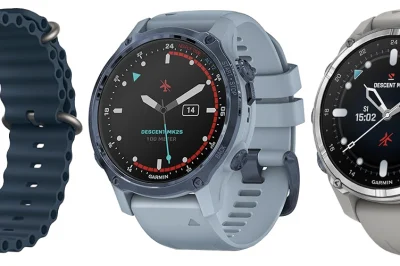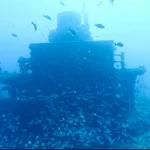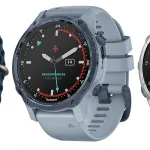Understanding the Vandenberg: A Diver’s Challenge

Table of Contents
- Understanding the Vandenberg: A Diver’s Challenge
- Why Redundancy Matters: The Case for Multiple Dive Computers
- Selecting the Right Dive Computer: What Florida Divers Recommend
- The Technical Diver’s Toolkit: Must-Have Features in 2023
- Latest Trends in Dive Computer Technology
- Debunking Myths: The Truth About Dive Computer Safety
- Statistical Benefits of Advanced Diving Computers
- Planning Your Dive: How Redundant Computers Enhance Safety
Introduction
This blog post delves into the growing trend among Florida’s technical divers who are equipping themselves with redundant diving computer systems to improve their experiences at the renowned Vandenberg wreck. We explore what makes these systems indispensable for both safety and efficiency when diving at such complex sites.
Understanding the Vandenberg: A Diver’s Challenge
Why Redundancy Matters: The Case for Multiple Dive Computers
Redundancy in dive computers is an essential aspect of ensuring safety and enhancing planning efficiency in technical diving. Using two independent dive computers significantly mitigates risks associated with equipment failure. In high-stakes environments like the Vandenberg wreck, having a backup system is not just an advantage; it is a necessity. A malfunctioning computer could lead to critical errors in tracking depth, time, and decompression limits.
Employing redundant dive computers creates a failsafe system, allowing divers to rely on continuous access to vital data. If one computer fails, the other can continue providing accurate readings. Real-world applications underscore this importance; divers equipped with backup systems have managed to avoid lengthy delays and interruptions during dives, enhancing overall dive safety and continuity.
Moreover, multiple dive computers enhance planning flexibility, enabling divers to create detailed dive profiles and adjust their ascent strategies dynamically. This flexibility is crucial when managing gas resources, especially following the “1/3 rule,” which suggests that divers should use no more than one-third of their gas supply before starting their ascent.
However, it is essential to balance reliance on technology with traditional safety methods. Even with advanced computers, divers should still carry manual backup tools such as dive tables and mechanical depth gauges, ensuring additional safety nets in case both electronic devices malfunction.
Why Redundancy Matters: The Case for Multiple Dive Computers
When selecting dive computers and navigating wreck diving conditions, divers commonly face pitfalls that can compromise safety and efficiency. Below are key mistakes to avoid and best practices tailored to wreck diving environments.
Common Mistakes When Selecting Dive Computers
- Overlooking Environment-Specific Features
- Failing to match the computer’s capabilities with diving conditions.
- Skipping features like multi-gas support or limited decompression planning for advanced dives.
- Neglecting Pre-Purchase Testing
- Buying without renting first to assess ergonomics, interface usability, or display clarity.
- Assuming entry-level models suit all needs; upgrading later is often more cost-effective.
- Ignoring Maintenance and Backup Protocols
- Purchasing used gear without verifying service history or battery health.
- Forgetting to bring spare batteries or a backup device on extended dives.
- Reliance on Manual Calculations
- Trusting outdated manual methods over real-time data from computers.
- Skipping Firmware Updates
- Failing to update wireless components.
- Improper Screen Care
- Not rinsing devices in freshwater or storing them in humid environments.
Best Practices for Wreck Diving with Computers
Device Selection
- Algorithm Choice: Opt for computers using moderate conservatism algorithms.
- Screen Visibility: Prioritise high-contrast, no-fog displays for low-light conditions.
Operational Tips
- Pre-Dive Checks
- Test screens and button functions on land.
- Validate gas settings for wreck penetration.
- Real-Time Monitoring
- Use decompression stop alerts and bottom-timer tracking.
Maintenance
- Battery Management
- Carry spare batteries and replace them at 30% capacity.
- Post-Dive Care
- Soak devices in freshwater to prevent salt corrosion.
Advanced Training
- Enroll in computer-specific courses to master settings like altitude adjustments and offboard gas usage.
Selecting the Right Dive Computer: What Florida Divers Recommend
Core Features for Advanced Dive Computers
When evaluating diving computers suitable for technical divers, it’s essential to focus on advanced features that enhance safety and usability in challenging environments.
- Multi-Gas Support: Advanced computers provide compatibility with multiple gas mixes, allowing for manual or automatic gas switching during a dive.
- Decompression Stop Management: Advanced models offer real-time guidance for mandatory decompression stops.
- Customisable Safety and Deep Stops: Users can pre-program safety stops and customise deep stops.
- Advanced Dive Planning Modes: These modes support complex dive planning by calculating multi-stage decompression or repetitive dives.
- Surface Interval Tracking: This feature monitors the time between dives, adjusting residual nitrogen calculations.
Specialised Advanced Capabilities
- Nitrox Optimisation: Advanced computers adjust maximum depth based on the percentage of oxygen in the gas.
- High-Precision Ascent Monitoring: Devices alert divers when they exceed safe ascent rates.
- Enhanced Dive Logging: Store detailed profiles including depth, gas mix, temperature, and decompression stops.
- Intuitive User Interface: A user-friendly interface simplifies the process of managing advanced dive modes.
Considerations for Technical Divers
- Gas Sensor Integration: Allows auto-detection of tank pressure.
- Algorithm Customisation: Some models permit adjustment of bubble models for personalised risk management.
- Trimix Support: Essential for deep technical dives to manage hypoxic risks.
Modern dive computers effectively balance safety with versatility, adapting to evolving diving techniques and optimal gas management strategies.
The Technical Diver’s Toolkit: Must-Have Features in 2023
Latest Trends in Dive Computer Technology (2023)
Dive computers have evolved significantly in 2023, showcasing technological advancements that enhance safety and usability for divers. Here are the key trends shaping the market:
Air Integration Advancements
Many dive computers now incorporate air-integrated systems that provide real-time monitoring of tank pressure through transmitters linked to the diver’s regulator.
Safety-Focused Redundancy
Utilising two dive computers concurrently ensures that if one device malfunctions, the other remains operational.
Decompression Algorithm Precision
Manufacturers are improving decompression algorithms to calculate safer ascent profiles more precisely.
Market Growth and User-Centred Design
The global wrist dive computer market is projected to grow significantly, driven by increased participation in recreational diving.
High-Oxygen and Technical Diving Support
Dive computers now offer enhanced gas analysis for nitrox diving, crucial for technical divers needing precise gas management.
Technological Integration
Leading models prioritise wireless connectivity for updates, data transfers, and compatibility with third-party applications.
These trends illustrate a shift towards enhanced safety, technological integration, and specialisation in dive computer technology.
Latest Trends in Dive Computer Technology
Key Features for Technical Diving
When diving the USNS Vandenberg, advanced dive computers are essential for safe exploration. While there is no dedicated “Vandenberg dive computer,” the latest models, such as the Descent G1 and Oceanic+, have features suitable for technical divers.
Recommended Dive Computers
- Descent G1
- Big Numbers Mode: Enlarges deco data for readability.
- Intuitive Operation: Smooth navigation with double-tap screen cycling.
- Multi-Gas Support: Allows for gas switching.
- Slim Profile: Lightweight design.
- Oceanic+
- Simplified Interface: Clear display of essential data.
- Analog Compass: Backup for navigation.
- Lightweight Design: Ergonomically designed.
Considerations for Diving the Vandenberg
The wreck’s structure demands precise tools. Features to prioritise include:
- Precision Depth Tracking: Ensures safe bottom times.
- Rebreather Compatibility: Extends exploration of spaces.
- Redundant Systems: Manage deep-water challenges.
2023 Technical Priorities
Advancements in dive computer technology focus on user-friendly redundancy:
| Feature | Descent G1 | Oceanic+ |
|---|---|---|
| Gas Switching | Advanced multi-gas | Simplified options |
| Deco Alerts | Big Numbers Mode | Essential data display |
| Ergonomics | Streamlined console | Lightweight handheld |
| Safety Redundancy | Double-tap data cycling | Analog compass backup |
The Descent G1 is favoured for focusing on technical diving, while the Oceanic+ offers essential functionalities for novices.
Debunking Myths: The Truth About Dive Computer Safety
The USS Vandenberg, located off the coast of Florida, is a premier technical diving site. It presents unique challenges requiring meticulous planning. Technical divers aiming for greater bottom times need to prioritise precise dive planning and implement robust redundancy strategies for safety.
Modern dive computers manage dive profiles, providing instantaneous data on essential metrics such as depth, bottom time, and decompression obligations. However, the complexities of diving the Vandenberg often lead divers to adopt redundant systems, including using two dive computers as a safeguard against single-point failures.
Redundancy Practices
Diving the Vandenberg typically involves:
- Dual Dive Computers: Set to conservative algorithms, they enable cross-checking decompression obligations.
- Backup Tools: Additional resources like bottom timers or traditional dive tables serve as fail-safes.
Risks and Mitigations
The Vandenberg comes with inherent risks. Equipment failure, depth, and temperature changes can undermine safety. Implementing redundant systems helps maintain critical data even during malfunctions.
Local Diving Regulations
While specific Florida regulations regarding redundancy practices aren’t detailed, adherence to established technical diving protocols is critical. Guidelines from bodies such as Divers Alert Network promote safety.
Statistical Benefits of Advanced Diving Computers
Scuba diving computers and redundant systems offer significant advantages for technical divers, particularly in environments like Florida’s complex wreck and cave systems. Here’s how these systems enhance safety and efficiency:
Computational Redundancy
Dual dive computers provide independent tracking of dive profiles, decompression obligations, and gas pressures. This ensures accurate data continuity if one device fails. Technical divers often configure one computer as conservative for primary use and the second with high conservatism for emergency scenarios.
Multi-gas compatibility enables real-time adjustments for complex dive plans, though some divers prefer pre-dive planning with software and use computers as backup tools. Computers also integrate cylinder pressure monitoring, alerting divers to dwindling gas levels.
Physical and Operational Redundancy
Twin-tank setups paired with independent regulators ensure continued gas supply and breathing options in emergencies. Isolation valves maintain redundancy.
PO2 monitoring through redundant sensors in rebreathers adds safety by continuously verifying oxygen levels, crucial for Florida’s deep or confined dives.
Planning and Safety Enhancements
Dive computers calculate no-decompression limits and ascent speeds using real-time depth and time data, reducing DCS risks. Structured pre-dive planning combined with computers as bail-out tools is often recommended for technical operations.
Built-in logs and downloadable data simplify post-dive analysis, helping divers refine future plans.
Key Advantages for Technical Diving
- Dual computers: Independent tracking; emergency conservatism adjustments
- Multi-gas integration: Real-time gas switches
- Cylinder pressure alerts: Prevents gas shortages
- PO2 monitoring: Redundant oxygen warnings for rebreather use
By combining computational redundancy with physical backup systems, Florida technical divers gain critical safeguards against equipment failure and complex dive profiles.
Planning Your Dive: How Redundant Computers Enhance Safety
Key Features for Technical Divers
The Vandenberg artificial reef in Florida presents a wealth of opportunities for technical divers seeking to expand their skill set in complex environments. A high-quality dive computer is essential for navigating its challenging depths and structures.
- Depth Range: The Vandenberg lies at varying depths, with the main deck around 100 feet and the superstructure rising 47 feet below the surface.
- Structural Access: The wreck allows advanced divers to enter various compartments.
- Marine Life: The wreck attracts diverse marine species, adding to the ecological richness.
Benefits of Technical Diving at Vandenberg
- Advanced Skill Development: Divers can practice skills such as gas consumption management and navigating vertical structures.
- Historical Exploration: The intact wreck offers insights into Cold War naval technology and ship design.
- Logistical Accessibility: Situated approximately six miles southeast of Key West, the dive site is easily accessible.
Requirements for Diving
- Certification: An advanced open water certification or equivalent is required.
- Equipment: Essential gear includes a reliable dive computer, redundant air sources, and buoyancy control devices.
- Physical Demand: The considerable length and currents in the area necessitate physical fitness and careful plans.
Sources
- Divers Alert Network – Risk and Redundancy
- Scuba Tech Philippines – Backup Computers in Technical Diving
- DRA Diving – Equipment Redundancy Strategies
- Scuba Junkie – What to Consider When Buying a Dive Computer
- Divessi – Mastering Dive Computers: Essential Guide
- Paragon Dive Store – A Scuba Diver’s Guide to Avoiding Common Equipment Mistakes
- Scubapro – Dive Computer Essentials: Choosing the Right One
- TDISDI – Dive Computers Guide





